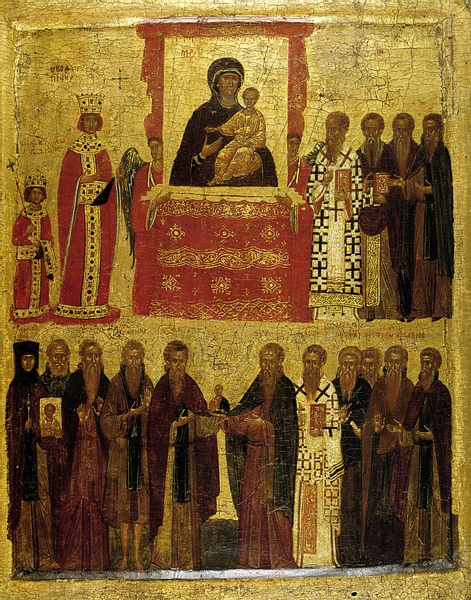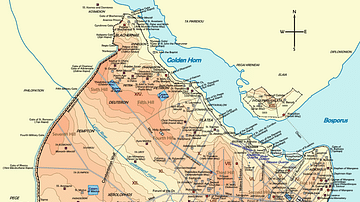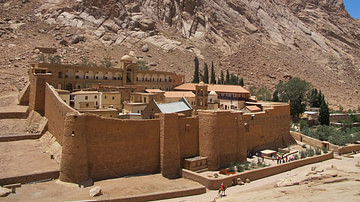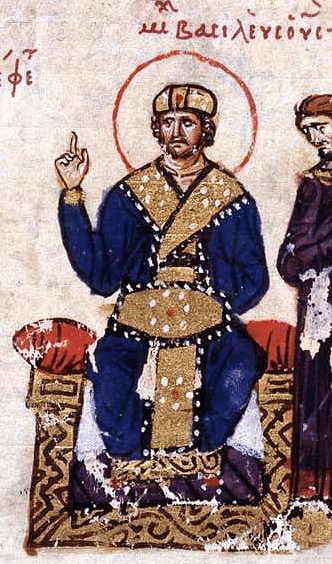
Michael III, also known as “Michael the Drunkard” by his detractors, was emperor of the Byzantine Empire from 842 to 867 CE. Never quite escaping the shadow of his mother Theodora, who ruled as regent in his name until c. 855 CE, or his uncle Bardas, the gifted chief minister, Michael's reign nevertheless saw significant religious and political changes and a strengthening of the empire, especially in the east. He was murdered and succeeded by the very man he had promoted in court and eventually appointed co-emperor, Basil I.
Theodora as Regent
Michael was born in 839 CE to Emperor Theophilos (r. 829-842 CE). When the aged and popular ruler died in 842 CE the powerful court eunuch and chief minister Theoktistos and Michael's mother Theodora both governed as the new emperor's regents. Michael had an older sister, Thekla, and the two siblings appear on the reverse of gold coins minted by their mother.
Theodora, a long time closet iconophile despite her late husband's opposite policy, saw to it that the veneration of icons was restored as Christian orthodoxy in March 843 CE. It was an action which became known as the “Triumph of Orthodoxy” and one for which she was later made a saint. Just to be on the safe side and ensure no negative fall-out for her son, Theodora made sure that Theophilos was not condemned by the Church as a heretic for his policy on the destruction of icons. She even spread the rumour he had repented of his sins on his deathbed. As hoped for, the late emperor was given a pardon and so avoided being forever mentioned alongside infamous heretics in church services thereafter. Theodora's great moment with the Church is commemorated in a famous Constantinople icon which dates from the early 15th century CE but is itself a copy of an older one. In it, the regent holds Michael in her arms while she is adoringly surrounded by priests and martyrs.
Michael & Bardas
In 855-6 CE Michael overthrew his regents, eliminating Theoktistos and banishing his mother to a monastery, to finally claim the throne in his own right. One area of discord between Michael and his mother had been her insistence he take Eudokia Dekapolitissa as his wife when he already had a mistress, one Eudokia Ingerina. However, it was still a family member who pulled the political strings at court, this time his uncle, Caesar Bardas, brother of Theodora. Bardas had no qualms about assassinating his brother-in-law Theoktistos so that his nephew, still in his teens, could be more easily manipulated by himself. Eventually, in 865 CE, Michael removed Bardas too but, in any case, he would enjoy his throne for less than two more years.
Important Events
Many of the significant events of Michael's reign are credited to those family members who ruled in his name. The veneration of icons in the Christian Church was reinstated by Theoktistos and Theodora, as already seen. Bardas was held responsible for establishing the famous university in the Magnaura hall of the Royal Palace at Constantinople where one of the faculties was headed by Leo the Mathematician (and philosopher and inventor). The chief minister also organised the mission of Saint Cyril and his brother Methodius to Moravia in 863 CE, and the baptism of the Bulgar Khan Boris I (r. 852-889 CE) in 864 CE. The latter event was largely conducted under duress according to official records, Boris being threatened with invasion if he did not bow to Byzantine Christian supremacy and renounce paganism in his kingdom. The Byzantines were certainly concerned that the Bulgars might forge a powerful alliance with the Franks but Boris, too, may have been keen to court Constantinople as an ally. Michael III became Boris' godfather to add a veneer of cordiality to the agreement.
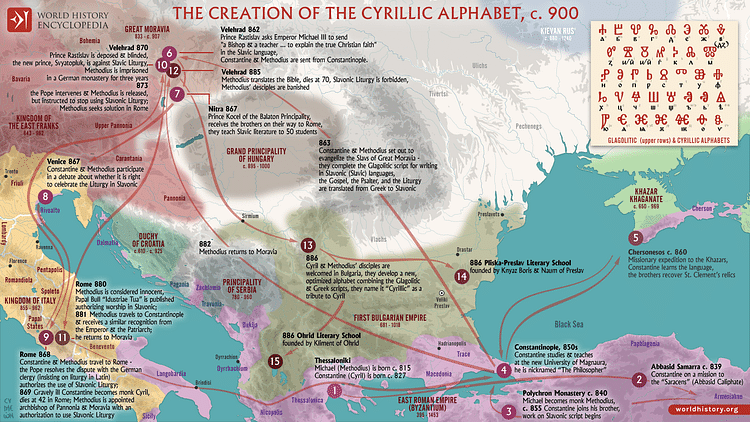
Military victories and the strengthening of the empire's eastern borders, in particular, were also thanks to experienced generals rather than Michael if the official records are to be believed. Men like Petronas, the strategos or military governor of the Thrakesion region (theme) of the empire, were the real reason for success. Petronas had served under Michael's father Theophilos, was the brother of Theodora, and it is true that he did much to ensure Byzantine military success abroad. In 856 CE Petronas headed spectacular campaigns in Mesopotamia and Cappadocia but it is recorded that Michael too went on campaigns in person. The Byzantines then destroyed the army of Umar, emir of Melitene, on the northern Mesopotamian frontier in 863 CE. The cities of Ankyra and Nicaea in Asia Minor were rebuilt as a result of these new gains. Whoever was responsible, the Byzantine empire was on the up again.
Death
The young emperor seemed content with wine, parties and good companions rather than governing - Igantios, the Bishop of Constantinople, publicly rebuked the court for its immorality in 858 CE but he was dismissed for his troubles. Michael's decision to mostly leave matters to Uncle Bardas was probably the best one of his reign. By far the worst decision, though, was his monumental miscalculation of promoting a certain uncouth Armenian within the court and then instructing him to assassinate Bardas. This shadowy figure, known as Basil the Macedonian because he had once spent time with a group of prisoners of that region, was a gifted wrestler and horseman of lowly birth. Basil's life was a classic rags-to-riches story. Leaving his peasant family, he had sought his fortune in the metropolis of Constantinople and he certainly found it.
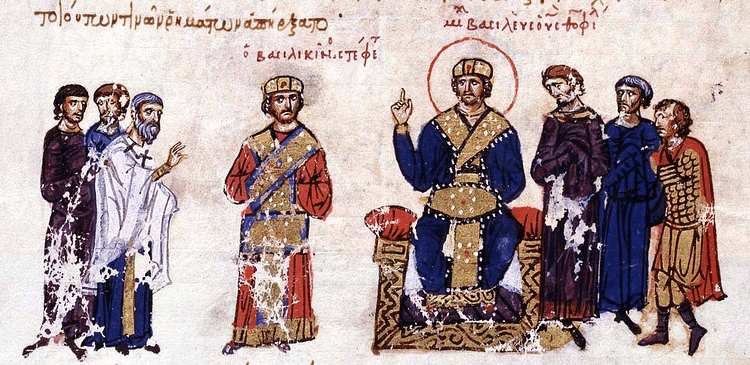
Basil's skills with horses led him to be put in charge of the imperial stables - Michael was a keen charioteer - and from there, when spotted by the emperor, he was made guardian of the imperial bedroom (parakoimomenos). In his new role Basil removed, by any means he saw fit, the enemies of the emperor. The pair also had a complex, ill-defined and much-debated relationship with Eudokia Ingerina - Basil actually marrying her but this may have been a ruse on Michael's part to have his mistress close at hand in the palace. Even more extraordinary, in 866 CE Michael made Basil co-emperor in a lavish ceremony in Hagia Sophia. The Armenian assassin would turn out to be just as treacherous to his sponsor, though, and he murdered Michael in his bedchamber in 867 CE, claiming the throne for himself under the title Basil I.
Legacy
Michael's epithet as a drunkard derived from critical court chroniclers eager to please his assassin and successor Basil I (r. 867-886 CE), founder of the Macedonian dynasty which would reign for 200 years. The stories may have been exaggerated but they had some truth in them, especially regarding the last five years of Michael's reign. His case is by no means unique in Byzantine history and the murder of such a debauched good-time Charlie as Michael, in the official records at least, became not only entirely justifiable but absolutely necessary for the stability and holiness of the institution of emperor. In a final irony and perhaps a sweet revenge from beyond the grave, Basil's successor, perhaps even his murderer, would be Leo VI (r. 886-912 CE), widely rumoured to actually have been the son of Michael III. It is, perhaps, significant that one of the first acts of the new emperor was to exhume Michael III's body from his nondescript grave and entomb him in a fine marble sarcophagus in the Church of the Holy Apostles.
